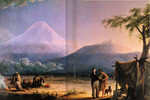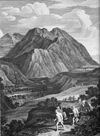Meeting 18 • 06 March 2014
|
Version: |
|
pictures of the week pictures of the week
|
|
|
|
mini-text of the week (start): "'…but the zambo would expect to be treated as an equal, and that I cannot do with a man of his colour.'"Humboldt, "Personal Narrative", from Jaguars and Electric Eels, ed. & trans. Wilson, pp. 47 (read more) |
|
•√ (05') Thought-bite, mini-text of the week and a picture of the week (Cargueros): When have you, in an encounter with people who are different from you (what does THAT mean?), changed / refused to change one of your beliefs, convictions, customs? (OK to begin with the little stuff, like eating patterns or clothes, but get to the tough decisions, like using or not using a Carguero) By the way, who are YOUR "people" and how do you and they know it? |
|
•√ (10') New Humboldtian reading for me: A World of Rivers: Environmental Change on Ten of the World's Great Rivers, by Ellen Wohl (2011). The Ob, and my sneaking suspicion that Wohl is presenting not just a collection of rivers but also a collection of different fundamental causes for environmental degradation. Attempt at a list of such causes / blames - not the science details, but rather the human attitudes (with plenty of blame to go around). Attempt at defining / naming the opposite of "sustainable environmentalism" and findings ITS origins. When did "sustainable environmentalism" (and its opposite) emerge, or have they been around forever? Enlightening side issue: When I go to Germany this summer for STEM workshop, how will I express "sustainable environmentalism" in German? |
|
•√ (10') Checking data during hearing test at Kaiser-Permanente: What is the difference between "normal" hearing and "mild" or "moderate" impairment? How accurately do they calibrate which equipment? how quiet is "quiet"(KP test room; anechoic rooms in PDX and Ohio, bug noise at night in Africa)? An audiologist's experience with culture contact in Africa: take the book/Book or take the money? |
|
•√ (10') Culture contact, "clash of civilizations", "First Encounter" (continued from previous meeting): culture contact and languages in SF - Damon Knight, "To Serve Man"; TR among the peoples of Humboldt-land (see handout from meeting #16); what to do? isolate, annihilate, integrate, imitate? what if the "natives" / "local yokels" don't want to benefit from our wisdom, goodness, and wealth? what if they do? When can indigenous languages (not) be saved? (Ostler, Nicholas. Empires of the Word: A Language History of the World) |
|
•+ (10') 99% vs. 1% (of a different kind) Quick point about the Chimborazo graphic: Humboldt's pioneering work in plant (and animal) geography: the 99% perspiration and data are combined with 1% inspiration and insight to produce the monumental, iconic "Chimborazo" graphic. That was the best they had "back then" about sustainable environmentalism: the data, the thought, the presentation in words and pictures. There was NO "Big Science": no government-sponsored science (until late in 19thC in US - Powell's fights), no corporate-financed R&D. Well, there was a little, especially for military purposes (mapping, weapons). But most science was "amateur" (gentleman and a few others), because science then was not regarded as important. Producing that engraving involved huge effort and expense, even after the data was collected. –Some other "iconic" images related to science (whether as concepts or as means to deliver data effectively). –Special points: natural history collections; rarity of travel; topographic mapping (Wikipedia; Geosciences, Idaho State U) |
|
•+ (10') Grants, jobs, résumé lines: 1) through PSU Institute for Sustainable Solutions; also PSU Student Research Symposium; also upcoming: Sustainability Celebration, 28 May; maybe a couple of our people will present their ideas; grants and conferences elsewhere; see earlier handouts for examples of internships; also: Horticultural Internship Program (paid!) at National Tropical Botanical Garden (www.ntgb.org) - click on "Education", then "Courses & Internships") in Hawaii. More soon about documenting your skills / achievements and the larger topic of employability. Want group feedback about how much to do this. "Résumé lines": "When you leave college you have to be able to list at least two things you've done that set you off from the competition" (=look good on application; topics for job/scholarship interviews). Funding for travel / projects (general PSU - SALP/AAA; Sustainability Institute); what they look for, and what they don't like. |
|
•+ (05') Initial advice about "educated citizen" reading, with examples (individual texts, publications - with free copies); see handout for Meeting #16: review of major scholarship about slavery; short, excellent article about sustainable enviromentalism; "Women at the Top" and the need for "downward mobility". Why I regularly read publications that I usually disagree with. |
|
•+ (05') Preview of final exam: 1) delivering concentrated facts about Humboldt's life, travels, work, and relation to sustainable environmentalism (but not on-demand facts, and they have to be organized); 2) relating AvH to our world ("Interpreting the Past"), without substituting preaching for documentation; 3) (you guessed it) another picture (and by now you should have a pretty good idea which one it will be, and what the theme will be); 4) reflection about an article that you will get at the next meeting (and can refer to during the exam); 5) check sheet so we can be sure you get all the credit you deserve for your contribution to your group project. Here's the scoring guide. |
|
Coffee / juice / snack, anyone? |
|
• On the horizon: Soon: A last quantification activity: precise measurement of altitude / distance (demo, then do in groups). Thought questions: Are all angles and degrees created equal? Why use a barometer to measure altitude when the theodolites and trig tables are there? Margins for error in Humboldt's time and our own: latitude, longitude, altitude, temperature; news flash: PSU Building World's Biggest Barometer!! Soon: How did/do people "feel" about nature and environmentalism? (NOT expressing opinions, but rather the psychological / emotional sense, including how we can encounter their thoughts / emotions Soon: topographical mapping and iso-dimensions looking ahead: presentation of project ideas (just the ideas, not finished projects) at meeting #16 Upcoming: presentation about society back then (and any time before 1800 or so), to help understand how H related to people of other classes / races (teaser: When was it that someone's ears first popped with a change in altitude?) What/how do we FEEL about sustainable environmentalism? Not our opinions, but rather our emotions - and also how such emotions have been |

